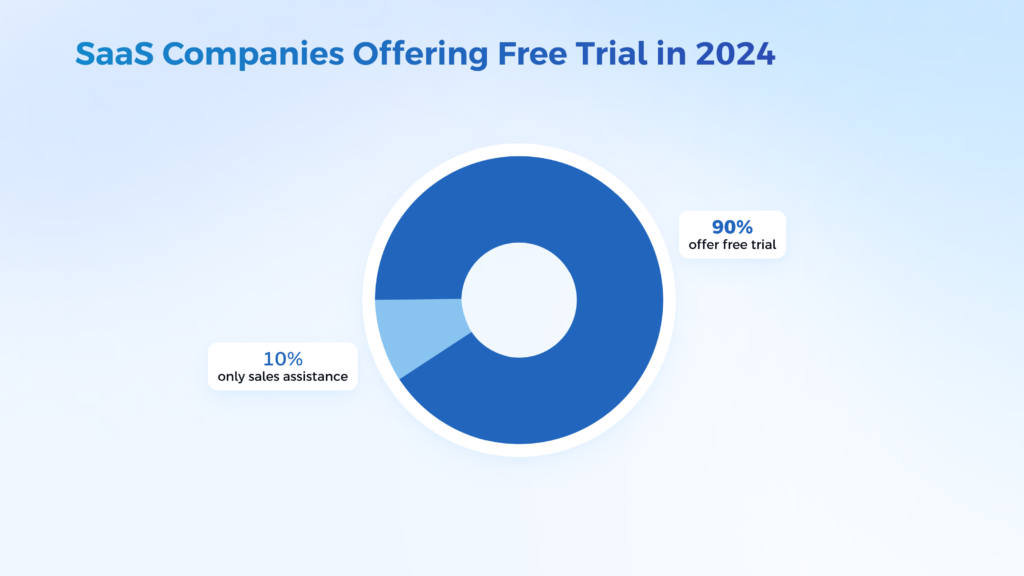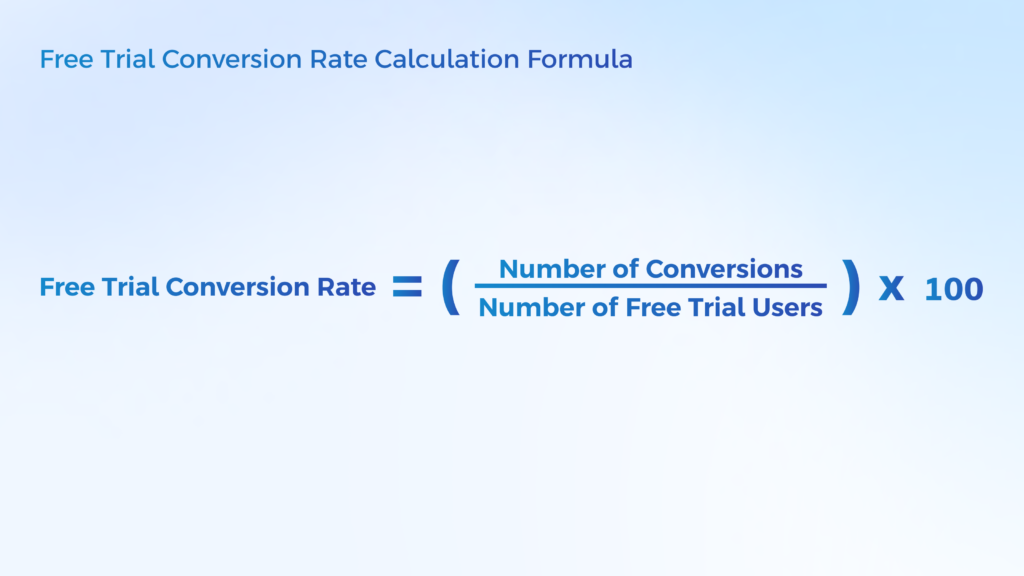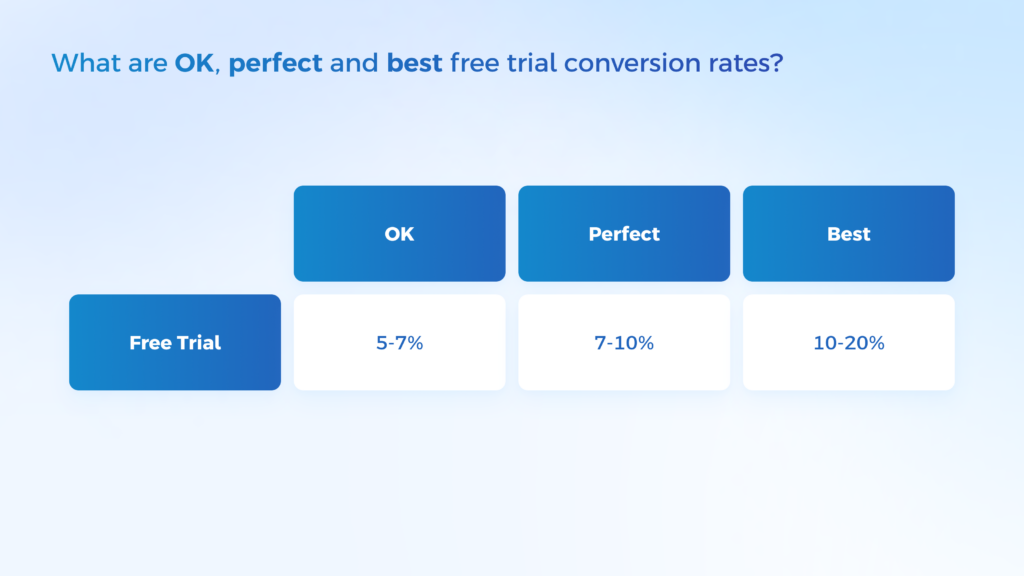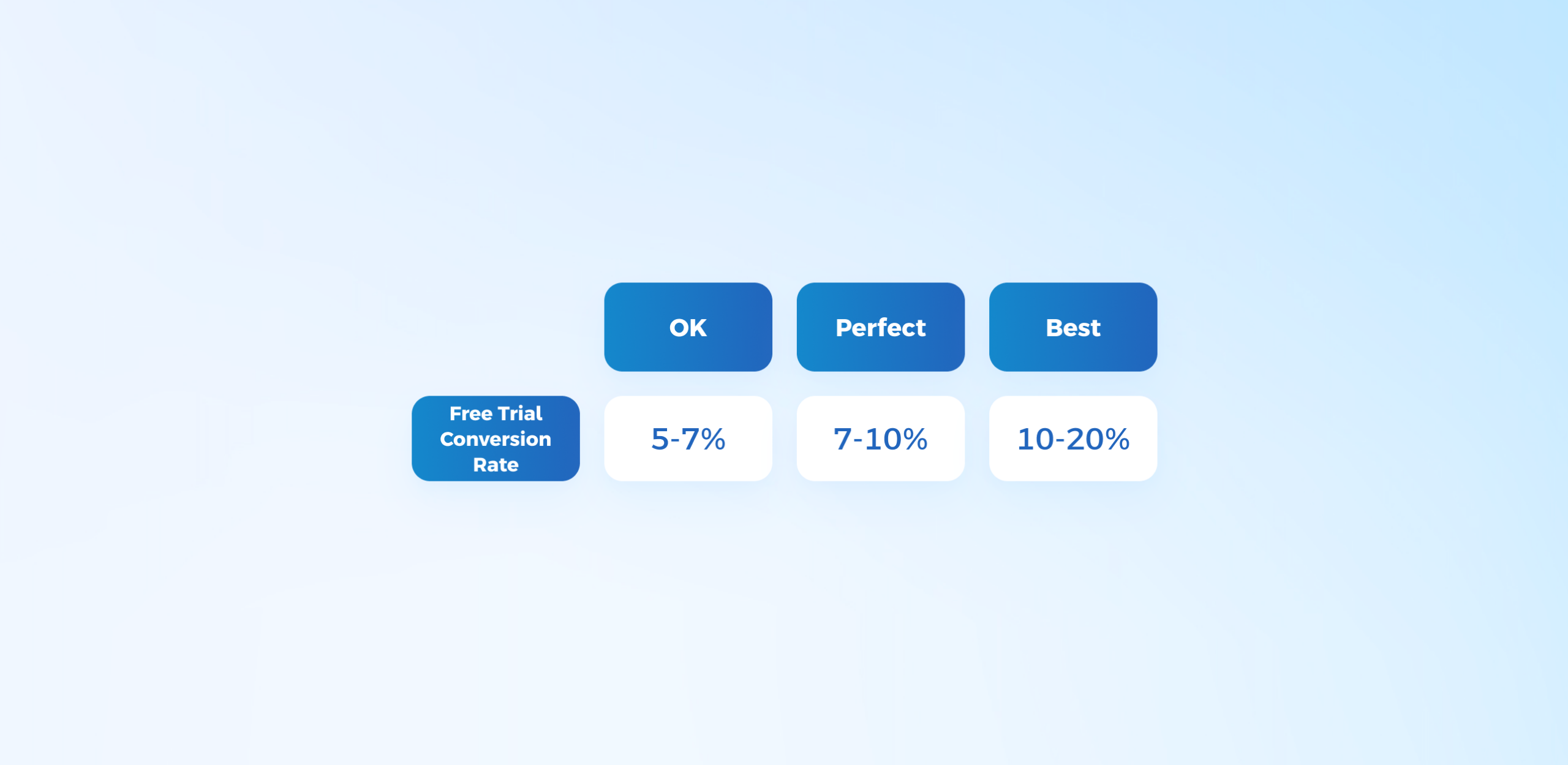There are several strategies when selling a SaaS, and free trials are at the centre of most of them.
Your self-service sales strategy might include free trial periods, free credits, free usage limits, etc., all of which are for users who self-sign up to get value from your product, understand its capabilities and ultimately subscribe to a paid plan.

In fact, the latest data suggests that approximately 17,000 SaaS companies exist worldwide. And according to Paddle’s 2023 report, approximately 90% of them offer a free trial in various forms.
This large adoption highlights the importance of free trials in the SaaS industry and makes understanding and improving your free trial conversion rate highly important.
What is free trial conversion rate?
Free trial conversion in a SaaS environment refers to the ratio of users who sign up for a free trial of your software to paying customers. It simply measure the percentage of users convert. A high conversion rate indicates that users can find significant value in your product during the trial period.
PRO TIP: If you rely on product-led more than sales-led, then it is the KEY metric that shows you how your self-service strategy is working.
The free trial conversion rate can reveal:
- the effectiveness of your product
- the performance of your onboarding
- how well the user experience designed
- are you really targeting the right customer profile
- and a lot about your self-service sales strategy
How to calculate free trial conversion rate?
It is pretty simple to calculate the free trial conversion rate. We need to:
- Determine the time period for which we want to calculate the conversion rate.
- Count the total number of users who started a free trial during the specified period. This includes all users who signed up, regardless of their activity level or engagement during the trial.
- Count the number of users who converted from the free trial to a paid subscription during the same period. A conversion is typically defined as a user who transitions to a paid plan after the trial ends.
- Use the following formula to calculate the free trial conversion rate:
- Free trial calculation rate = (number of conversions ÷ number of free trial users) x 100

Example calculation
Suppose in the month of April, 500 users started a free trial of your SaaS product. By the end of April, 75 of these users had converted to a paid subscription. Using the formula:
(75 ÷ 500) × 100 = 15%
In this example, the free trial conversion rate for April is 15%.
Factors to consider
When calculating and interpreting your free to paid conversion rate, consider the following factors:
Length of trial period
Different trial lengths can impact conversion rates. Shorter trials may pressure users to make a quick decision, while longer trials give users more time to see the value in your product.
User segmentation
Segment your users based on different criteria (e.g., company size, industry, user role) to see if certain segments have higher or lower conversion rates.
Engagement metrics
Track engagement metrics during the trial period to identify which actions correlate with higher conversion rates.
What is the best free trial conversion rate?
There is no one-size-fits-all answer to what constitutes the best free trial conversion rate, as it can vary widely depending on the product, target market, and sales strategy.
However, we can provide approximate benchmarks based on industry data and insights from our 10+ years in SaaS and conversations with other SaaS founders.

- OK: 5%-7%
- Perfect: 7%-10%
- Best: 10%-20%
Factors influencing conversion rates
Target audience
- Larger enterprises tend to have lower conversion rates due to more stakeholders and complex requirements.
- Developer-focused products often have lower conversion rates compared to non-developer-focused products.
Product type
- Free trial products generally have higher conversion rates than freemium products due to the urgency and commitment associated with a trial period.
Sales involvement
- Products with sales assistance during the trial period tend to have higher conversion rates as the sales team can address specific customer needs and objections.
How are different SaaS companies rates look like?
Micro-SaaS or Very Small Businesses (VSM)
It varies between 5% – 20%.
A low conversion rate among micro-saas or very small businesses might indicate that these users struggle to see the immediate value. Enhancing the onboarding process and offering special discounts or flexible payment options could improve this rate.
The higher conversion rate reflects a strong alignment between the product’s value proposition and the needs of very small businesses. It indicates that the product effectively addresses their pain points and delivers clear.
Small to Medium-Sized Business (SMB)
It varies between 4% – 20%.
At the lower end, this rate may suggest that SMBs find the product too complex or not immediately relevant to their needs. Simplifying the user experience and providing targeted onboarding can help increase this rate.
A high conversion rate here indicates that SMBs find significant value in the product. This suggests that the product is well-suited to their operational needs and that the trial experience is compelling and informative.
Mid-market
It varies between 4% – 16%.
For midmarket customers, a low conversion rate often reflects longer decision-making processes and more complex requirements. Providing detailed resources and facilitating stakeholder buy-in can be important.
A higher conversion rate suggests that the product meets the complex needs of midmarket companies effectively. It indicates a strong value proposition and a successful trial experience that addresses key business challenges.
Tips to improve your free trial conversion rate
- Optimize onboarding for your ideal customer profile.
- Provide personalized support.
- Use behavioral triggers like automated emails or in-app messages.
- Not too long; not too short trial periods. Set a proper trial period to create urgency.
- Extend trials for engaged users.
- Highlight success stories and ROI.
- Segment and target different user groups.
- Simplify the user experience.
- Incorporate sales assistance.
- Analyze and improve engagement metrics.
Key takeaways
- The free trial conversion rate measures the percentage of users who sign up for a free trial of your software and subsequently convert to paying customers.
- A high conversion rate indicates that users find significant value in your product during the trial period.
- Different customer segments require tailored onboarding experiences to see the product’s value quickly.
- Offering personalized support and engagement during the trial period can significantly impact conversion rates.
- Clear and compelling demonstrations of the product’s value, particularly through case studies and ROI examples, are important for converting trial users to paying customers.
- Products with sales assistance during the trial period tend to have higher conversion rates.





